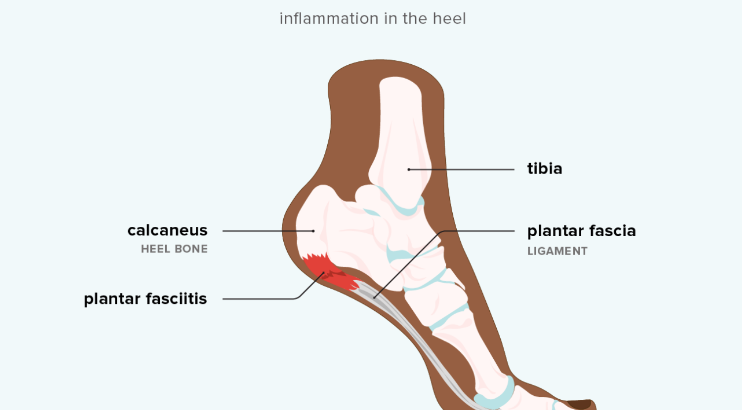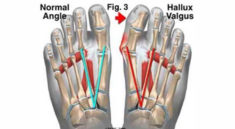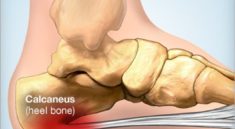Nothing can disrupt normal daily living quite as much as pain that keeps you from moving around.
If you’re experiencing pain in the bottom of your heel, it may be worth getting checked out. Your planta fascia ligament may be inflamed, which could be causing your pain.
Depending on the cause and the extent of the inflammation, you may find relief with a nonsurgical treatment, but in severe cases, you could consider a surgical procedure.
In this article, we take a closer look at plantar fasciitis, its symptoms and causes, plus treatment options and recovery time.
What is plantar fasciitis?
Plantar fasciitis causes pain in the bottom of the heel. The plantar fascia is a thick, weblike ligament that connects your heel to the front of your foot. It acts as a shock absorber and supports the arch of your foot, helping you walk.
Plantar fasciitis is one of the most common orthopedic complaints. Your plantar fascia ligaments experience a lot of wear and tear in your daily life. Too much pressure on your feet can damage or tear the ligaments. The plantar fascia becomes inflamed, and the inflammation causes heel pain and stiffness.
The cause of plantar fasciitis discomfort is still unclear. A 2003 study suggested that the condition may involve degenerationTrusted Source rather than inflammation of the plantar fascia. Because fasciitis means “inflammation of a fascia,” a better name may be plantar fasciosis.
What are the primary symptoms of plantar fasciitis?
The major complaint of those with plantar fasciitis is pain at the bottom of the heel or sometimes at the bottom mid-foot area. It usually affects just one foot, but it can affect both feet.
Pain from plantar fasciitis develops gradually over time. The pain can be dull or sharp. Some people feel a burning or ache on the bottom of the foot extending outward from the heel.
The pain is usually worse in the morning when you take your first steps out of bed, or if you’ve been sitting or lying down for a while. Climbing stairs can be very difficult due to heel stiffness.
After prolonged activity, the pain can flare up due to increased irritation or inflammation. People with plantar fasciitis don’t usually feel pain during the activity, but rather just after stopping.
What causes plantar fasciitis and who gets it?
Plantar fasciitis isn’t typically the result of heel spurs. Doctors used to believe that heel spurs caused pain in people with plantar fasciitis, but this isn’t the case.
Plantar fasciitis tends to develop as a result of overstretching or overuse of this ligament, although a tear or small tears in the fascia tissue can also cause the pain. Your foot structure can also predispose you to developing plantar fasciitis.
Active men and women between the ages of 40 and 70 are at the highest risk for developing plantar fasciitis. It’s also slightly more common in women than men. Women who are pregnant often experience bouts of plantar fasciitis, particularly during late pregnancy.
Risk factors
You’re at a greater risk of developing plantar fasciitis if you:
- are overweight or have obesity. This is due to the increased pressure on your plantar fascia ligaments, especially if you have sudden weight gain.
- are a long-distance runner.
- have an active job where you are often on your feet, such as working in a factory or being a restaurant server.
- have structural foot issues, such as high arches or flat feet.
- have tight Achilles tendons, which are the tendons attaching your calf muscles to your heels.
- often wear shoes with soft soles and poor arch support.
How do doctors diagnose plantar fasciitis?
Your doctor will perform a physical exam to check for tenderness in your foot and the exact location of the pain. This is to make sure that the pain isn’t the result of a different foot problem.
During the evaluation, they may ask you to flex your foot while they push on the plantar fascia to see if the pain gets worse as you flex and better as you point your toe. They’ll also note if you have mild redness or swelling.
Your doctor will evaluate the strength of your muscles and the health of your nerves by checking your:
- reflexes
- muscle tone
- sense of touch and sight
- coordination
- balance
Imaging tests
Imaging tests can also reveal important information about the structures and tissues within your foot. An X-ray or an MRI scan may be necessary to check that nothing else is causing your heel pain, such as a bone fracture.
Although you can’t really get a good look at soft tissues on an X-ray, the test is still useful for ruling out bone fractures, heel spurs, and other possible culprits.
Meanwhile, research Trusted Source suggests that an MRI can provide evidence of any thickening of the plantar fascia or swelling in the tissues.
An ultrasound may also be useful Trusted Source to see if there’s any thickening, calcifications, or other issues.
How is plantar fasciitis treated?
Home treatments like rest, icing, and using braces and anti-inflammatory drugs are often the first ways to treat plantar fasciitis. If those don’t ease the pain, an injection of a corticosteroid directly into the damaged section of the ligament can help. Your doctor can do this in their office.
Your doctor may use an ultrasound image to help determine the best place for the injection. They can also apply corticosteroids to the skin of your heel or the arch of your foot, and then apply a painless electrical current to let the steroid pass through your skin and into the muscle.
Nonsurgical treatment for plantar fasciitis
Physical therapy
Physical therapy is a key part of treatment for plantar fasciitis. It can help stretch your plantar fascia and Achilles tendons. A physical therapist can show you exercises to strengthen your lower leg muscles, helping to stabilize your walk and lessen the workload on your plantar fascia.
Shock wave therapy
If pain continues and other methods aren’t working, your doctor may recommend extracorporeal shock wave therapy. In this therapy, sound waves bombard your heel to stimulate healing within the ligament. Side effects of this treatment can include:
- bruises
- swelling
- pain
- numbness
Extracorporeal shock wave therapy Trusted Source hasn’t been proven to be consistently effective in relieving symptoms. If home and medical treatments don’t take care of your plantar fasciitis, the next option to consider is surgery.
Stretching exercises
Gentle stretches can help relieve and even prevent plantar fasciitis. Stretching your calves and the plantar fascia itself helps loosen your muscles and reduce heel pain.
It’s important to take time off from certain exercises, like running, to give the plantar fascia time to heal. Swimming and other low-impact activities can let you exercise without worsening your heel pain. When you start running again, be sure to begin slowly.
Stop and stretch while exercising to keep the pain from returning. Remember to stretch before beginning your workouts, too.
Stretches for plantar fasciitis are easy to do. You’ll only need a few common props, like a chair and a foam roller, or even just a frozen water bottle.
Surgical treatment for plantar fasciitis
Surgery is the most dramatic therapy. This is done only in cases in which pain is severe or lasts more than 6 to 12 months.
Surgery can result in chronic pain and nerve damage, so it should be considered only after trying other treatment options.
Gastrocnemius recession
If you have a hard time flexing your feet even after consistent stretching, your doctor may recommend gastrocnemius recession. This surgery involves lengthening the calf muscle to increase ankle motion and flexibility in the foot and release stress on the plantar fascia.
A 2018 retrospective reviewTrusted Source of 17 patients found that this type of surgery improved foot function and reduced pain in people who are overweight or have obesity who also have chronic plantar fasciitis. But while this surgery does seem to help some people with recalcitrant plantar fasciitis, more research is needed, according to a 2021 review of existing research.
Plantar fascia release
In a plantar fascia release, your surgeon will cut part of your plantar fascia ligament to release some of the tension, which should hopefully relieve the inflammation. This may entail small cuts into the ligament, or it could entail detaching the plantar fascia from the heel bone. The process can be performed endoscopically or via open surgery.
This reduces tension, but weakens the arch of the foot, and full function may be lost.
Home remedies for plantar fasciitis
Reducing pain and irritation or inflammation in the plantar fascia ligament is an important part of treatment, but this doesn’t address the underlying damage to the ligament.
Home treatments for plantar fasciitis
Initial home treatment includes staying off your feet and applying ice for 15 to 20 minutes, 3 or 4 times per day, to reduce swelling.
You can also try reducing or changing your exercise activities. Using arch supports in your shoes, replacing worn-out athletic footwear, and doing stretching exercises may also help to relieve pain.
Nonsteroidal anti-inflammatory drugs (NSAIDs), such as ibuprofen (Motrin or Advil) and naproxen (Aleve), may soothe pain in the ligament.
Braces and supports for plantar fasciitis
Night splints are another treatment that can help stretch your calf and the arch of your foot. Night splints are a type of brace that holds your foot in a flexed position and lengthens the plantar fascia and Achilles tendon overnight. This can prevent morning pain and stiffness.
Special orthotics, or arch supports, for your shoes may help alleviate some of the pain by distributing pressure, and they can prevent further damage to the plantar fascia.
A boot cast may immobilize your foot and reduce strain while the plantar fascia heals. You can remove the boot cast, which looks like a ski boot, for bathing.
Carefully following recommendations for home treatment is often enough to heal plantar fasciitis without help from your doctor.
Essential oils for plantar fasciitis
There’s little research on treating plantar fasciitis with essential oils. Still, some studies suggest that using essential oils may reduce pain and inflammation for certain conditions. These oils include:
- lavender
- lemongrass
- eucalyptus
- rose
Dilute your essential oil with a carrier oil, like coconut oil, before using it for massage. You can also inhale the steam from the essential oil mixed with hot water.
Since it’s unclear whether plantar fasciitis involves irritation or inflammation, using these essential oils may not be much help. However, if you use them correctly, there’s generally no harm in trying them.
CBD oils for plantar fasciitis
Cannabidiol (CBD) is a compound found in the Cannabis plant, and products incorporating this compound are often used to treat pain and inflammation.
While there is not a significant body of research into the specific benefits of CBD for plantar fasciitis, numerous studiesTrusted Source have found that cannabis may be effective in relieving various types of pain, including one 2018 review that assessed the benefits of using cannabis to alleviate chronic pain and a 2015 review into the benefits of inhaled cannabis for chronic neuropathic pain.
It’s a good idea to talk to a healthcare professional before you try a product like CBD to discuss appropriate dosing and other issues. Then, if you want to give CBD oil a try, you can opt for a couple of different methods. You can use a dropper to place CBD oil under your tongue, or you can apply a topical product containing CBD oil to your skin.
Be sure to do a patch test first to make sure the product doesn’t irritate your skin and cause additional discomfort on top of your pain.
Nutrition and supplements for plantar fasciitis
More research is needed on using nutrition to improve or prevent plantar fasciitis. However, taking these supplements may help with tissue repair and healing:
- vitamin C
- zinc
- glucosamine
- bromelain
- fish oil
It’s better to get nutrients from eating a balanced diet than from supplements. If you do decide to take supplements, always check with your doctor first.
If weight gain caused your plantar fasciitis, eating a healthy diet can help you lose weight and relieve your heel pain. Here are 20 foods that can help you lose weight.
How long does it take to recover from plantar fasciitis?
For most people, plantar fasciitis improves within a few months of home treatments. These include resting, icing, and stretching.
You can also help your plantar fascia recover by stabilizing your foot with tape. This limits the amount that the ligament can move. A 2015 reviewTrusted Source of several studies suggested that taping your foot also offers temporary pain relief.
You can use zinc oxide tape or kinesiology tape. It may take some practice, but you can tape your foot yourself and aid the recovery process. Learn how to tape your foot to help relieve plantar fasciitis.
How can you prevent plantar fasciitis?
Making a few lifestyle changes may help you avoid plantar fasciitis.
Wear supportive shoes with good arch support, and replace your athletic footwear regularly. If you’re a runner, around 400 to 500 miles is the limit for each pair of shoes before you should buy new ones.
Incorporate low-impact exercises into your routine, like swimming or bicycling. Avoid overworking your plantar fascia with very frequent running. Before exercising, be sure to stretch your calves, Achilles tendon, and plantar fascia.
Do your best to stay at a healthy weight. If you’re overweight, try to lose weight to reduce pressure on your plantar fascia.
What’s the difference between plantar fasciitis and heel spurs?
A heel spur is a hook of bone that can form on the heel bone, or calcaneus, of the foot. Like plantar fasciitis, it can develop from long-term stress on your feet. An orthopedic surgeon or a podiatrist can diagnose a heel spur with an X-ray.
People often assume that foot pain is caused by a heel spur, but this usually isn’t true. Heel spurs often cause no symptoms.
According to the American Association of Orthopaedic Surgeons (AAOS), 1 in 10 people has a heel spur, but only 1 in 20 people with heel spurs experiences pain.
Conversely, a 2019 studyTrusted Source found that the majority of people over 50 with plantar heel pain reported the pain was “disabling.”
Heel spurs share similar causes with plantar fasciitis. Some of these include:
- wearing unsupportive or worn-out shoes
- being overweight
- having arthritis
- walking with an incorrect or unnatural gait
Having plantar fasciitis also increases your likelihood of forming heel spurs. Although heel spurs won’t heal without surgery, they typically don’t cause any pain or other symptoms. As a result, surgery usually isn’t needed.
You can treat heel spurs close to the same way you would treat plantar fasciitis. Rest and ice, pain medications, and shoe inserts can reduce symptoms.
Do children get plantar fasciitis?
Children, like adults, may develop plantar fasciitis from overuse of the ligament or from wearing old or unsupportive shoes. Because the condition can worsen over time, it’s important to see a doctor to properly diagnose and treat it.
Ice your child’s heel to reduce any irritation or inflammation. Massaging the area can also help it heal. Make sure your child rests and avoids running, jumping, and standing for long periods to help their foot heal.
When your child returns to their normal activities, remind them to do warmup exercises and stretches to keep the problem from returning. You should also check that they’re wearing properly fitting, supportive shoes.
Your child’s heel pain could also be another condition, like Achilles tendinitis or a fracture.
What are the potential complications of plantar fasciitis?
You can develop chronic heel pain if you ignore the condition. This can change the way you walk and cause injury to your:
- legs
- knees
- hips
- back
Steroid injections and some other treatments can weaken the plantar fascia ligament and cause potential rupture of the ligament.
Surgery carries the risks of bleeding, infection, and reactions to anesthesia. Plantar fascia detachment can also cause changes in your foot and nerve damage. Gastrocnemius recession surgery can also cause nerve damage.
Takeaway
Most people don’t need surgery to relieve pain from plantar fasciitis. Instead, their condition improves through physical therapy, home treatments, and medical treatments.
However, treatment can take several months to 2 years to improve your symptoms. In some cases, surgery may become an option that you might need to consider.
Regardless of what treatment you choose, don’t ignore your symptoms. Untreated plantar fasciitis can lead to more painful complications.




